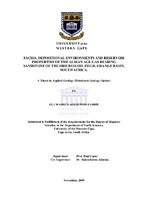| dc.description.abstract | The Orange Basin was formed during the late Jurassic to early Cretaceous periods due to Gondwana breakup and rifting and later drifting apart of the African and South American plates. The basin consists of siliciclastic sandstone which took its sediment supply from river system with a rivalling delta to the north of the basin. Geological and petrophysical studies were carried out to evaluate the reservoir potential of the wells in the study area. This study considered five wells (A-G1, A-W1, A-K1, A-K2 and A-Y1) in the Orange Basin with attention to the Albian age sandstone. Only three of the studied wells (A-G1, A-W1 and A-K1) have core samples for analysis. The methods used for the execution of this study include the description and calibration of spot cores with conventional standard logging record responses, wireline log interpretation using sequence stratigraphy approach, detailed petrographic (SEM, HR-TEM, XRD and thin section) and geochemical (pore water geochemistry, FTIR and XRF) analyses, and petrophysical analysis to unravel the complexities with regard to facies association, depositional environment and diagenesis. Linking diagenesis to depositional facies and sequence stratigraphy has given a clearer picture to the spatial and temporal distribution of diagenetic alterations and thus of evolution of reservoir quality in the studied wells. Three depositional lithofacies were identified based on a detailed core description [fine grained sandstone (F1), very fine grained sandstone (F2) and mudstone (F3)]. Fluvio-deltaic and shallow marine environments were also interpreted from the core description based on the sedimentary structures and mineral assemblage while the log interpretation shows that the different reservoir units range between LST, TST and HST but mostly of LST. Mineralogical predictions were made possible in the wells without core samples (A-K2 and A-Y1) through the use of density-neutron cross plot, these reveal that the two wells contain some considerable amount of clay minerals like kaolinite, chlorite and illite. | en_US |

